7 Smokable Plants You Can Grow That Aren’t Marijuana
Don’t worry, it’s totally legal
7 Smokable Plants You Can Grow That Aren’t Marijuana
Don’t worry, it’s totally legal

Quite a few plants may be safely, and pleasurable, lit up in a pipe or rolling papers. Those listed below are legal, unregulated, and totally safe to use. They are also non-hallucinogenic and non-addictive – perhaps that explains their lack of popularity?
While they won’t get you high, when blended according to the instructions below, these herbs produce a smooth, tasty smoke and give a gentle, relaxing buzz. All of the following varieties may be purchased online or at any well-stocked herb store. You may also grow your own. Of course, we’d be remiss not to remind you to discuss any questions with a doctor.
While scores of herbs are smokable, those listed below are among the most commonly used and easily grown at home. Skip to the sidebar to learn how to dry your herbs into the perfect smoking blend.
Mullein (Verbascum thapsus)
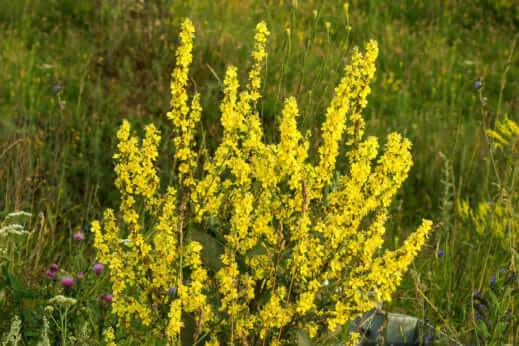
Herbal Properties: Mullein has a long history of use as a lung tonic. It can actually help you stop coughing when you’re sick.
Smoking Qualities: The smoke is extremely light and mild, almost like smoking air, and virtually flavorless.
Type of Plant: This biennial herb grows up to two feet wide at the base, with flower stalks rising six feet or more.
How to Grow: Considered by some a garden weed, this fuzzy-leafed plant is very easy to grow from seed planted directly in the garden in spring. It prefers a sunny location and soil that is well-drained and not too fertile. It benefits from a bit of irrigation as a seedling but is drought-tolerant once established.
Skullcap (Scutellaria spp.)
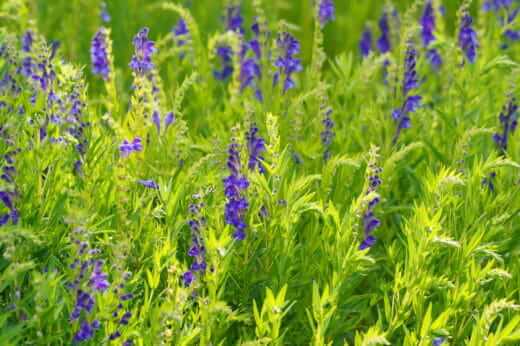
Herbal Properties: Skullcap has a mild calming effect when smoked.
Smoking Qualities: This herb is a medium smoke, with a fairly neutral flavor.
Type of Plant: A spreading perennial that grows about a foot tall, skullcap makes an attractive groundcover in the garden.
How to Grow: Sow seeds indoors in spring, planting the seedlings in a sunny or partly shaded location with rich soil once the weather has warmed. Skullcap requires weekly irrigation during dry periods. Cut the dried foliage to the ground each fall.
Coltsfoot (Tussilago farfara)

Herbal Properties: Coltsfoot is an expectorant, helping to free phlegm from the lungs.
Smoking Qualities: This herb is a light smoke with a neutral flavor, but can cause harsh coughing if used in a high concentration in smoking blends.
Type of Plant: This 6- to 12-inch tall groundcover spreads by underground rhizomes to form extensive colonies under optimum growing conditions.
How to Grow: Dried coltsfoot seed rarely germinates, but “fresh” seed, as well as potted plants, are available online. Rich, moist soil and a location in full sun or part shade are this plant’s preferred growing conditions.
Mugwort (Artemesia vulgaris)
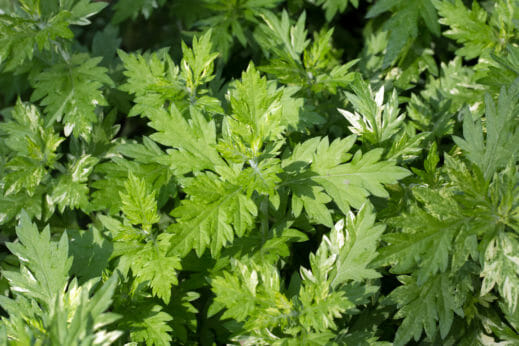
Herbal Properties: Many ancient cultures smoked mugwort to promote vivid dreams. It also produces a very mild psychotropic effect while you’re awake.
Smoking Qualities: This herb is a light smoke with a pleasant, slightly sweet flavor.
Type of Plant: Mugwort is a spreading perennial growing up to 2 feet tall.
How to Grow: While seeds are available online, mugwort is easier to start from a potted plant, or by transplanting a clump from an established patch. Mugwort thrives with little care once established, but beware: it can become invasive, especially in moist locations. Cut the dried stalks to the ground each fall.
Uva-Ursi (Arctostaphylos uva-ursi)
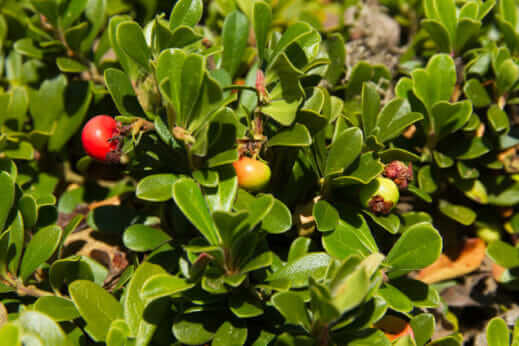
Herbal Properties: Also known by the Algonquin name kinnikinnick, this native plant has long been smoked by Native American tribes for ceremonial purposes.
Smoking Qualities: Uva-ursi herb is a medium smoke with a strong earthy flavor.
Type of Plant: This attractive woody groundcover, which grows about 6 inches tall, is a popular landscaping plant.
How to Grow: Uva-ursi is very difficult to propagate by seed, so it’s best to obtain potted specimens from a native plant nursery in your area, or from an online supplier. Grow in full sun or light shade; excellent drainage is essential. Uva-ursi is drought-tolerant and requires little care once established.
Mint (Mentha spp.)
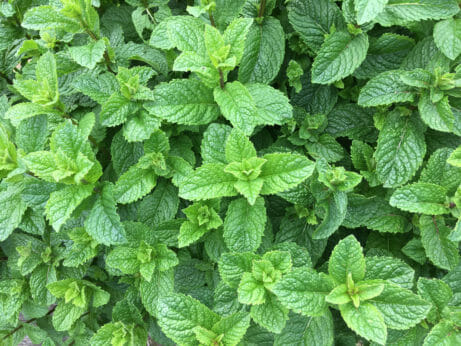
Herbal Properties: Mints are used primarily to impart flavor to smoking blends. There are many varieties worth experimenting with, including spearmint (Mentha spicata) (pictured above), peppermint (Mentha piperita), and chocolate mint (Mentha x piperita ‘Chocolate’). Close relatives of mint, including lemon balm (lemony flavor) and yerba buena (sweet menthol flavor), are often incorporated in smoking blends, as well.
Smoking Qualities: Varies by species.
Type of Plant: These herbaceous perennials spread to form extensive colonies under optimum growing conditions.
How to Grow: Mints are easier to establish from potted plants, or by transplanting a clump from an established patch, than by sowing seeds. Part sun and rich, moist soil are the preferred growing conditions. Mints can become invasive in the garden, especially in moist areas, so you may want to confine them to a pot. Cut the dried stalks to the ground each fall.
Sage (Salvia spp.)
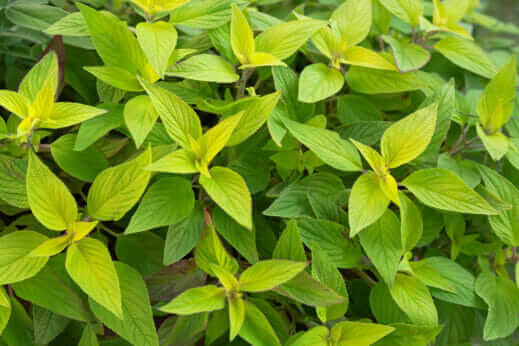
How to Make Your Own Herbal Smoking Blend
Smoking mixtures are largely a matter of personal tastes and preferences – experiment with different herb combinations to see what suits you best – but here are the basics to get you started.
General Guidelines:
Herbal Properties: Sages are used primarily to impart flavor to smoking blends. There are many varieties worth experimenting with, including white sage (Salvia apiana), black sage (Salvia mellifera), and pineapple sage (Salvia elegans) (pictured above). Beware though: One type of sage, Salvia divinorum, has strong psychotropic properties and is illegal in many states (many gardeners find themselves accidentally breaking the law).
Smoking Qualities: Varies by species.
Type of Plant: Most sages are shrubby perennials, ranging from less than 1 foot to more than 6 feet tall.
How to Grow: Growing conditions vary by species, but most sages prefer full sun and dry conditions. Cut them back about 50 percent each fall.
Follow us
This work is licensed under a Creative Commons Attribution-NoDerivatives 4.0 International License.
Want to republish a Modern Farmer story?
We are happy for Modern Farmer stories to be shared, and encourage you to republish our articles for your audience. When doing so, we ask that you follow these guidelines:
Please credit us and our writers
For the author byline, please use “Author Name, Modern Farmer.” At the top of our stories, if on the web, please include this text and link: “This story was originally published by Modern Farmer.”
Please make sure to include a link back to either our home page or the article URL.
At the bottom of the story, please include the following text:
“Modern Farmer is a nonprofit initiative dedicated to raising awareness and catalyzing action at the intersection of food, agriculture, and society. Read more at <link>Modern Farmer</link>.”
Use our widget
We’d like to be able to track our stories, so we ask that if you republish our content, you do so using our widget (located on the left hand side of the article). The HTML code has a built-in tracker that tells us the data and domain where the story was published, as well as view counts.
Check the image requirements
It’s your responsibility to confirm you're licensed to republish images in our articles. Some images, such as those from commercial providers, don't allow their images to be republished without permission or payment. Copyright terms are generally listed in the image caption and attribution. You are welcome to omit our images or substitute with your own. Charts and interactive graphics follow the same rules.
Don’t change too much. Or, ask us first.
Articles must be republished in their entirety. It’s okay to change references to time (“today” to “yesterday”) or location (“Iowa City, IA” to “here”). But please keep everything else the same.
If you feel strongly that a more material edit needs to be made, get in touch with us at [email protected]. We’re happy to discuss it with the original author, but we must have prior approval for changes before publication.
Special cases
Extracts. You may run the first few lines or paragraphs of the article and then say: “Read the full article at Modern Farmer” with a link back to the original article.
Quotes. You may quote authors provided you include a link back to the article URL.
Translations. These require writer approval. To inquire about translation of a Modern Farmer article, contact us at [email protected]
Signed consent / copyright release forms. These are not required, provided you are following these guidelines.
Print. Articles can be republished in print under these same rules, with the exception that you do not need to include the links.
Tag us
When sharing the story on social media, please tag us using the following: - Twitter (@ModFarm) - Facebook (@ModernFarmerMedia) - Instagram (@modfarm)
Use our content respectfully
Modern Farmer is a nonprofit and as such we share our content for free and in good faith in order to reach new audiences. Respectfully,
No selling ads against our stories. It’s okay to put our stories on pages with ads.
Don’t republish our material wholesale, or automatically; you need to select stories to be republished individually.
You have no rights to sell, license, syndicate, or otherwise represent yourself as the authorized owner of our material to any third parties. This means that you cannot actively publish or submit our work for syndication to third party platforms or apps like Apple News or Google News. We understand that publishers cannot fully control when certain third parties automatically summarize or crawl content from publishers’ own sites.
Keep in touch
We want to hear from you if you love Modern Farmer content, have a collaboration idea, or anything else to share. As a nonprofit outlet, we work in service of our community and are always open to comments, feedback, and ideas. Contact us at [email protected].by Brian Barth, Modern Farmer
July 18, 2018
Modern Farmer Weekly
Solutions Hub
Innovations, ideas and inspiration. Actionable solutions for a resilient food system.
ExploreShare With Us
We want to hear from Modern Farmer readers who have thoughtful commentary, actionable solutions, or helpful ideas to share.
SubmitNecessary cookies are absolutely essential for the website to function properly. This category only includes cookies that ensures basic functionalities and security features of the website. These cookies do not store any personal information.
Any cookies that may not be particularly necessary for the website to function and are used specifically to collect user personal data via analytics, ads, other embedded contents are termed as non-necessary cookies.
I recently quit tobacco and have found that mugwort has been a great replacement. I don’t have cravings for nicotine at all and my smokers cough has virtually disappeared. It grows in my garden so there is no expense.
You forgot Skip Dagga, aka Lion’s Ear. This plant’s flowers and leaves is best used as a calmative tea, something like valium, which is also plant derived. Grow your own euphoria, make a nice ice tea of it….don’t worry…be happy… and lay out on the hammock….. without getting locked up by law enforcement who should be out getting alcohol -drunk drivers.
11,000 fellow Americans killed last year on the highways of the USA by persons intoxicated via alcoholic beverages. .
I love smoking rosemary.It has a calming and relaxing benefits along with other medicinal purposes.
I know this post is over two years old, but I still felt like I had to write in and say that both coltsfoot and skullcap can be highly toxic, and mugwort can cause severe allergic reactions in some people. Uva-ursi is generally regarded as safe, but some people are sensitive to it and can react badly. Not trying to be a downer, just don’t want to see anyone get hurt.
Would like to get more info on growing of the 7 smokable plant and mixing of the plants to used for smoking .
im 71 and didn’t about most of this stuff ,now ill look into this info ..thank you
Is it safe to smoke sage. I have quit tobacco after 50 years but the smoking habit is hard to stop.. I am growing sage and mint are they safe?
The salvia that has the psychedelic properties is not that easy to grow without special conditions and wouldn’t even be mistaken for other salvias. Plants leaves, stems and textures are completely different. Needs a higher humidity environment for best growth. Just fyi. I don’t think its accidental if you are caring for a patch of it.
The Red Willow bark is another mild earthy smoke.. strip/peel off the red outer bark and then scrape the inner pale ‘tobacco’ from joint to joint of the branches.. dry this then smoke by itself or mix in with other smokables…
Thank you for the information that I requested I found it to be very informative.